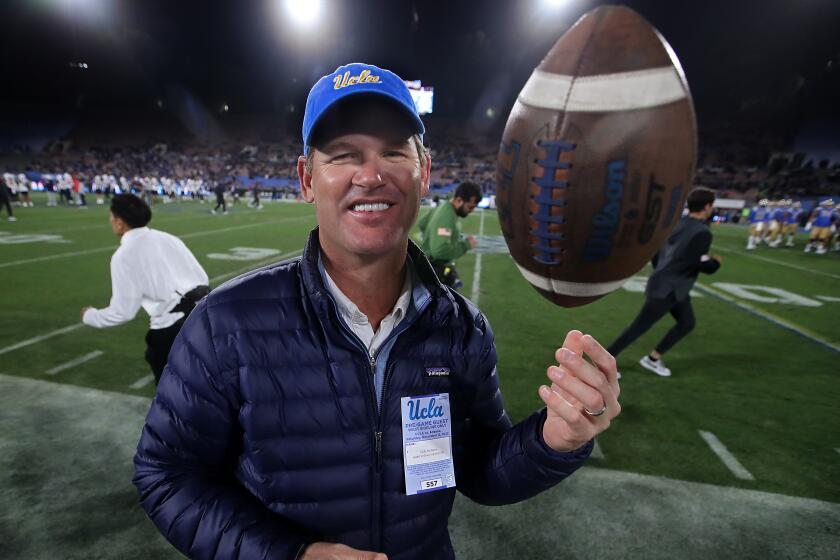New York Racing in Poor Shape
Belmont Park will be the international center of the racing world on Saturday, hosting the 22nd running of the Breeders’ Cup, but behind the scenes the New York Racing Assn., which operates the 100-year-old track and New York’s two other major thoroughbred tracks, is fighting for its financial life.
“They could be out of money in a month,” said Ben Liebman, a former member of the New York State Racing and Wagering Board who is coordinator of a racing and gaming law program for the Albany (N.Y.) Law School.
The NYRA, which also runs Aqueduct, not far from JFK Airport, and Saratoga in upstate New York, was created by many of racing’s bluebloods in 1955. The association has been not-for-profit from the beginning, but lately the three tracks have been honoring that charter to the point of extinction. Saratoga, which runs an abbreviated summer meet not unlike Del Mar’s, makes money. But Aqueduct and Belmont operate well into the red. Overall, the NYRA hasn’t finished in the black since 2000 and, according to the Thoroughbred Times, has lost more than $50 million since then.
Charlie Hayward, the former Daily Racing Form publisher who stepped in as NYRA chief executive last year, has gotten high marks for trying to right the ship, including an emphasis on integrity and security that should comfort horseplayers. But his watch may have come too late. Earlier this month, Hayward told a state oversight committee that the NYRA should sell 80 acres of non-racing property near Aqueduct, which might raise $20 million in needed cash. Last week, Hayward said that the NYRA plans to sell 15 of its 100 or so paintings at public auction.
“It always seems like somebody is clipping at our heels,” he said wearily this week.
Bobby Frankel, the Hall of Fame trainer, has gone full circle with New York racing, from its halcyon days when he would sneak over the fence to get in, to the disarray it has become. Frankel, who stables horses in California and New York, will run three horses in two Breeders’ Cup races Saturday, including favored Leroidesanimaux in the Mile. He said that when Belmont Park was awarded the 2005 Breeders’ Cup, a few years ago, the regime before Hayward’s promised that a special chute would be built to accommodate the start of the 1 1/4 -mile Classic, at $4.68 million the richest race on the card. But instead, the fourth Classic to be run at Belmont will again start from an angle on the clubhouse turn. Post positions could disproportionately affect a race that might decide horse-of-the-year honors.
“They didn’t have the money to build the chute,” Frankel said. “And there are a lot of other things around here where the lack of money shows.”
A Breeders’ Cup official, asking that his name not be used, said that an ongoing discussion with the NYRA regarding the building of a chute lasted until December of last year.
Many of racing’s most famous horses have run at Belmont, whose Belmont Stakes in June climaxes the Triple Crown series. A record crowd of 120,139 watched Smarty Jones’ unsuccessful bid for the crown last year. But less than half that will attend Saturday, in part because a slew of racing’s best horses -- including Frankel’s Ghostzapper, last year’s horse of the year -- are injured or retired.
If the NYRA doesn’t go broke first -- which might lead to the state of New York taking over -- it could go out of business when its franchise expires at the end of 2007. Churchill Downs Inc., the company that owns the Kentucky Derby track plus other racing properties, and Magna Entertainment Corp., owner of Santa Anita and several other tracks, are said to be interested in applying for the license.
Joseph Bruno, majority leader in the New York Senate, has gone from the NYRA’s ally to calling for a change. The NYRA has contributed as much as $140,000 a year to Bruno’s campaign funds.
For the NYRA, if there is a light at the end of the tunnel, it is the possibility that the association could install 4,500 slot-machine-like games at Aqueduct. The casino, which is expected to take in $1 billion annually -- to be shared with the state and horsemen in the form of racing purses -- has a target date of the fourth quarter of 2006. The NYRA, which would net 30% of the profits, could then begin paying off its many debts, which include $60 million to the Capital Investment Fund, begun 22 years ago to finance improvements to the three tracks.
A more recent hit came when the NYRA was fined $3 million by the federal government, which said that some NYRA officials had countenanced, for 20 years, a scheme in which its parimutuel clerks defrauded the government of tax money. In May, the NYRA fired 59 clerks and suspended 30 more after they had called in sick on the day Belmont Park was importing a telecast of the Preakness, the middle leg of the Triple Crown.
This month, two NYRA clerks of scales, including former Hall of Fame jockey Braulio Baeza, were accused in an indictment of allowing jockeys to ride even though they were five to 12 pounds overweight. Both were fired.
Former racing board member Ben Liebman is not sure privatization of the New York tracks will be a panacea.
He said a reconstructed, refinanced NYRA, armed with slot machines and a clean bill of ethical health from its federal monitor, would seem to have as good of a shot at succeeding as any private group. “It’s not that there are any unblemished white knights seeking the franchise,” he added.
Observers say that if the NYRA gets a reprieve it would need a better business plan and a more inventive mind-set.
“In its good years,” Liebman said, “there was no incentive to make a profit, no need to cut costs at any time. The pensions they gave out were generous and bloated. There was little accountability. The public has never been told who authorized using the horsemen’s fund to pay operating expenses. Nobody was penalized for those actions. There was no explanation why there was no competitive bidding on some of the [remodeling contracts] that NYRA let.
“So much has [happened] that it’s hard to figure out what happened and why. Getting to the bottom of things is a lot like handicapping on a muddy track.”
More to Read
Get our high school sports newsletter
Prep Rally is devoted to the SoCal high school sports experience, bringing you scores, stories and a behind-the-scenes look at what makes prep sports so popular.
You may occasionally receive promotional content from the Los Angeles Times.






